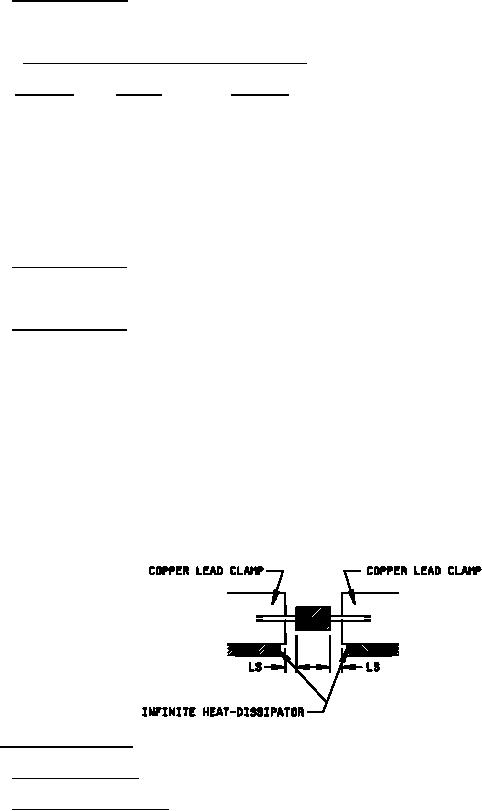
MIL-PRF-19500/629C
* 4.4.3 Group C inspection. Group C inspection shall be conducted in accordance with the conditions specified for
subgroup testing in table VII of MIL-PRF-19500. Electrical measurements (end-points) shall be in accordance with
the applicable inspections of table I, subgroup 2 herein.
* 4.4.3.1 Group C inspection table VII of MIL-PRF-19500.
Method
Condition
Subgroup
C2
2036
Tension: Test condition A; weight = 20 pounds; t = 15 s. Lead fatigue:
Test condition E; weight 1 pounds. NOTE: Both tension and lead
fatigue are not applicable for US suffix devices.
C5
3101
See 4.4.5 herein.
TA = 90°C; VRWM = 40 V(pk); IO = 0, half sine wave, f = 60 Hz. TA
C6
1026
adjusted to achieve TJ = +110°C minimum.
* 4.4.4 Group E inspection. Group E inspection shall be conducted in accordance with MIL-PRF-19500 and the
conditions for subgroup testing herein. Electrical measurements (end-points) shall be in accordance with table I,
subgroup 2 herein.
* 4.4.5 Thermal resistance. Thermal resistance measurement shall be in accordance with method 3101 or 4081 of
MIL-STD-750. Forced moving air or draft shall not be permitted across the device during test. The maximum limit for
RθJL under these test conditions shall be RθJL (max) = 20°C/W, RθJEC (max) = 10°C/W. The following conditions shall
apply when using method 3101:
a. IM ................... 1 mA to 10 mA.
b. IH .................... 3.0 A.
c. tH ................... 20 seconds minimum.
d. tMD ................. 100 µs maximum.
LS = lead spacing = .375 inch (9.53 mm) for non-surface mount devices and 0 inch for surface mount devices as
follows:
4.5 Methods of inspection. Methods of inspection shall be as specified in the appropriate tables and as follows.
4.5.1 Pulse measurements. Conditions for pulse measurement shall be as specified in MIL-STD-750.
4.5.2 Steady-state operation life. This test shall be conducted with a half-sine wave of the specified peak voltage
impressed across the diode in the reverse direction followed by a half-sine waveform of the specified average
rectified current. The forward conduction angle of the rectified current shall not be greater than 180 degrees nor less
than 150 degrees.
9
For Parts Inquires call Parts Hangar, Inc (727) 493-0744
© Copyright 2015 Integrated Publishing, Inc.
A Service Disabled Veteran Owned Small Business